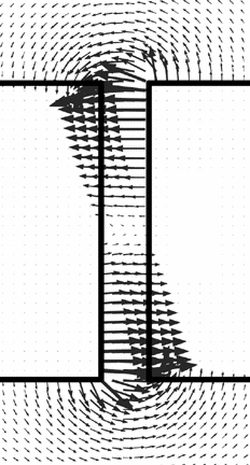Light Sneaks through Small Holes
According to textbooks, light is not supposed to pass through a hole smaller than its wavelength, but in the past two years, physicists have done just that: An array of small holes in a thin layer of metal transmits certain wavelengths surprisingly well. While researchers have shown that vibrations of electrons on the metal surface (plasmons) are involved, the 4 October PRL contains the first detailed analysis of the phenomenon. The authors’ computer simulations show how the light gets through and confirm the key role of plasmons. These perforated metal slices may be put to use in making faster microchips or better electronic displays.
You expect a silver plate to effectively reflect light, but changing the structure on the scale of a wavelength of light can make a dramatic difference, explains John Pendry of Imperial College, University of London. The dark regions of black-and-white photographic negatives are filled with a dense layer of microscopic silver particles, but they hardly reflect any light at all. Similarly dramatic effects on optical properties occur with microstructures like photonic crystals–materials that block transmission of a specific range of wavelengths of light–and the new “holey metal” phenomenon.
To learn about the mechanism for light transmission through tiny holes, Pendry and his colleagues at Imperial College and the Autonomous University of Madrid simulated the system with a computer program that accounts for many details of the interaction. The team’s biggest difficulty was including the electromagnetic properties of the metal, which depend strongly on the frequency of the light. To ease the computing load, they simplified the geometry a bit by assuming slots, rather than holes, but their results still look similar to the experimental data. They show that for slits 0.5 µm wide, the transmission is maximized (above 80%) for a narrow range of wavelengths centered at between 4 and 10 µm, depending on the metal thickness.
According to the simulations, incoming light excites plasmon modes–waves of “sloshing” electrons on the metal surface–which transmit the energy through the slit and convert it to light on the opposite side of the slab. “The stuff that’s actually going through the hole isn’t light at all,” explains Pendry. The simulations also show that the transmission is sensitive to the metal thickness because plasma waves essentially resonate inside the slots, much like the vibration of air in organ pipes. The team cautions that, although they are confident in their theoretical explanation for the experimental data, the difference in geometry between simulations and experiment means more work must be done to be sure.
Pendry is most interested in making use of the strong electric fields created as the light energy is squeezed through such a small hole. “You’re pressing all this energy into a very small volume,” he says, and it might be used to make sensitive measurements on single molecules, for example, since normal lenses can’t focus laser light into such small spaces.
“These are very important results which give new insight into the details” of the transmission process, says Thomas Ebbesen of Louis Pasteur University in Strasbourg, France. He led the team (at NEC Research Institute in Princeton, NJ) that discovered the surprising phenomenon last year. He says the results suggest more experiments and development that will lead to new devices.
More Information
Qing Cao and Philippe Lalanne, “Negative Role of Surface Plasmons in the Transmission of Metallic Gratings with Very Narrow Slits,” Phys. Rev. Lett. 88, 057403 (2002)





